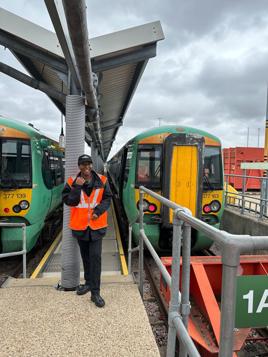“I did not even know there were any women train drivers!” laughs Leigh Santamaria.
“I had been on a career break for ten years. I looked at the requirements for a trainee, and I thought: well, that’s me.”
Leigh is one of five female trainee drivers at Govia Thameslink Railway who have all been out of work for extended periods.
“I can’t say I was dreaming of driving a train. It was not an obvious choice for me. But I succeeded.”
GTR wanted a cohort of eight trainees. But the assessments were stringent - only five got through.
The operator is endeavouring to increase diversity across its business, to better reflect the passengers it serves.
Each time it advertises trainee driver vacancies, thousands of people apply. But instead of choosing the best candidates who came through the door, it deliberately sought people who might not have considered the role, and who had been out of mainstream employment.
GTR has more than 7,400 staff and carries more than one in six of all passenger rail journeys in the UK - over 800,000 passengers a day. In 2023, 40% of train driver recruits were female.
“We want to search for talent from different pools,” explains Zoey Hudson, head of talent, diversity and inclusion.
“We want people from different walks of life, with different perspectives. And this was a pool we hadn’t considered or come across.”
That pool is an organisation called Career Returners, with a database of 9,000 people seeking employment. Most are women who have paused their careers to raise families.
Zoey explains: “If we all think the same and look the same, it makes life a bit flat. It doesn’t bring the variety and engagement we want. We need people with different ways of being, different ways of thinking.
“It’s about diversity of thought in an industry that has been around a long time. Train drivers have been predominantly male, predominantly white. GTR is about 80% male, yet we are one of the most diverse train operators! We need to turn the dial on that, and we have a very long way to go.”
Leigh Santamaria is 52. She is nearing the end of her six months of training at Selhurst depot in south London. Soon, she will be out on the tracks, driving trains from Victoria station.
“I have been on a career break for ten years, because I have a child with special needs. I was taking care of her, but she is 15 now,” she says, with an accent that is hard to place.
“I went to school in South Africa. I’m not actually South African - my father was from Manchester, my mum Irish. I was born in Saudi Arabia and I’ve lived around the world. Now I’m in Kent.”
Many years earlier, Leigh was a flight attendant. Later, she worked in the legal business and then studied accountancy, qualifying during her years at home. Driving a train was therefore far from an obvious change of direction.
“I came across the Career Returner programme. I looked at the opportunities and applied without much expectation.
“There were many stages in the recruitment process, and the psychometric tests were really tough. We had to sit the same tests as everyone else. I got through those, and started to believe I stood a chance.
“I was over the moon! I have been working really hard at the training, and I am really pleased I made this move.”
It started with personal track safety. Next came signalling. They moved on to simulators, mastering low adhesion in treacherous weather conditions, and emergency evacuations. Learning the Rule Book, she says, was “intense”.
“I was nervous about doing the Traction module. That’s the one all along that worried me. I looked at everything I could see underneath the train, and I asked the trainer if I really had to know how it all worked. He said I did. But I succeeded.”
Next, Leigh must complete 225 hours on track under the supervision of a driving instructor.
“Only after that, when he believes I am ready, can I do the competency assessment. Over five days, I’m told you are questioned pretty hard. Then you have the final assessment with an external tester, before you get your ‘key’ - your driving licence in effect.”
What do her family and friends think of this change of direction?
“My children, when they first saw me in uniform with my safety boots, said I didn’t look very good. My friends were a bit shocked. But they’re really happy for me.
“My mum lives two minutes away. My special needs daughter is at an excellent school, and I have top-notch support there. I rely on them. My younger daughter is 13. So I can do this now.”
Elba Lovelace-Francis is about to start driving under instruction, having completed her desk-based and simulator training. When she qualifies, she will be based at Northwood depot.
“I stumbled across the returners programme on Twitter, or X, completely by chance,” she says.
“I’d actually had the idea of driving trains back in school. It was an all-girls’ school, and one of the other girls went off and became a driver. I’d known about it, but never put my foot in that puddle.
“Then I saw it again on the returners’ site. I had a one-year-old child. But I just went for it. I’d worked in a bookie’s before - long hours, late nights, lots of trust, handling data.
“I’m still quite shocked I got through.”
Elba joined the training course at Selhurst last August. Like Leigh, it was the Traction module she found hardest. Her daughter is now in nursery, and her mum is about to retire, intending to take on the childcare.
“For me it was the security of the role,” she says.
“And it feels like an important job. My previous jobs didn’t feel so important - didn’t feel like a career. And this leads to so many other possibilities. The pay is an incentive as well, but it’s good to feel you are doing something that matters.”
Hazel Little, of Career Returners (the organisation which has partnered with GTR), tells RAIL: “The challenges are structural as well as psychological.
“It starts with recruitment bias - people who had a gap on their CV are automatically screened out. Returners tend to be a little older, and generally female.
“The psychological bias is predominantly loss of confidence, the feeling of self-doubt.”
Why should GTR care about this group of people, when driver jobs are already heavily over-subscribed and hugely competitive?
“They get thousands of applicants for their trainee driver programme,” Hazel concedes.
“The partnership with us was initially around female representation. They weren’t reaching enough women.
“Career returners have valuable experience. Many have been in professional roles for many years, and they’ve gained further experience and skills during their breaks.
“For the company, this is about benefiting from high-calibre, experienced talent. It’s a way of increasing diversity of gender, age, ethnicity, and also cognitive diversity.
“It’s about the life skills that returners bring in, with renewed enthusiasm, excitement, commitment, and loyalty as they get back into careers.”
Career Returners is a small organisation of 12 people spread across the UK, all of them working from home. It started ten years ago. It has provided support and coaching to 170 employers and their workers across many sectors. But this is the first time that train drivers have been involved.
“It’s about setting people up for success,” says Hazel.
“It’s about questioning the recruitment process, making sure organisations are inclusive of this talent - supporting the company, the employees and their line managers.
“At GTR we have these five fabulous trailblazing returners who have come through the programme. It’s about role models.”
Will more Returners follow?
Leigh and Elba are exceptional. So is every trainee who makes it to day one on the course at Selhurst, before they’ve even put on the uniform for the first time.
More than 1,000 people applied for the driver training through the Returners programme. Five made the grade, having to meet the same selection standards as any other trainee.
But that is still much better odds than other candidates face. Overall at GTR, they were told that applicants for the job of trainee driver face a 1-in-3,000 chance of success.
Zoey Hudson explains: “The Returners are from very different backgrounds. We have someone from investment banking, and someone who was a teacher.
“They go through exactly the same robust and stringent assessment process as anyone else. There’s no difference in the standards we require them to meet - it’s just that these people haven’t been in the workplace for an extended period of time.
“In other roles, we have apprentices who are in their 70s. We’ve had a team leader and supervisor in training at the age of 72. Absolutely we get a return on that investment, because it brings a different sort of diversity. An older person will think differently.”
How do the interviewers choose people with large gaps in their CVs, over and above the many more obviously suitably qualified candidates who swamp them after every round of recruitment advertising?
“That’s where Career Returners come in,” Zoey replies.
“They have thousands of people on their platform. They did the attracting of talent using their connections, so we had a direct link to a different talent pipeline from anything we had before. We specifically wanted to target this specific group of people.
“It’s also about upskilling managers to change the way they select candidates. Traditionally when you spot a gap in a CV it raises questions. We have to move away from any stigma associated with that.”
How will success be measured?
“Retention,” she says simply. “The five individuals will all pass their programmes. When you become a train driver in GTR you are automatically on our apprenticeship scheme. Career Returners also provide coaching and mentoring for that group of people, so there is a lot of support around them.
“I think the four-day working week appeals to this group of people as well. “It’s shifts, but we have the ability to work those shifts around caring responsibilities.”
Once this pilot has been completed, GTR plans to use the same path for other roles.
“Train driver is the first element of a programme,” Zoey concludes.
“It brings different experiences to the roles, and different skills to the organisation.”

















Login to comment
Comments
No comments have been made yet.